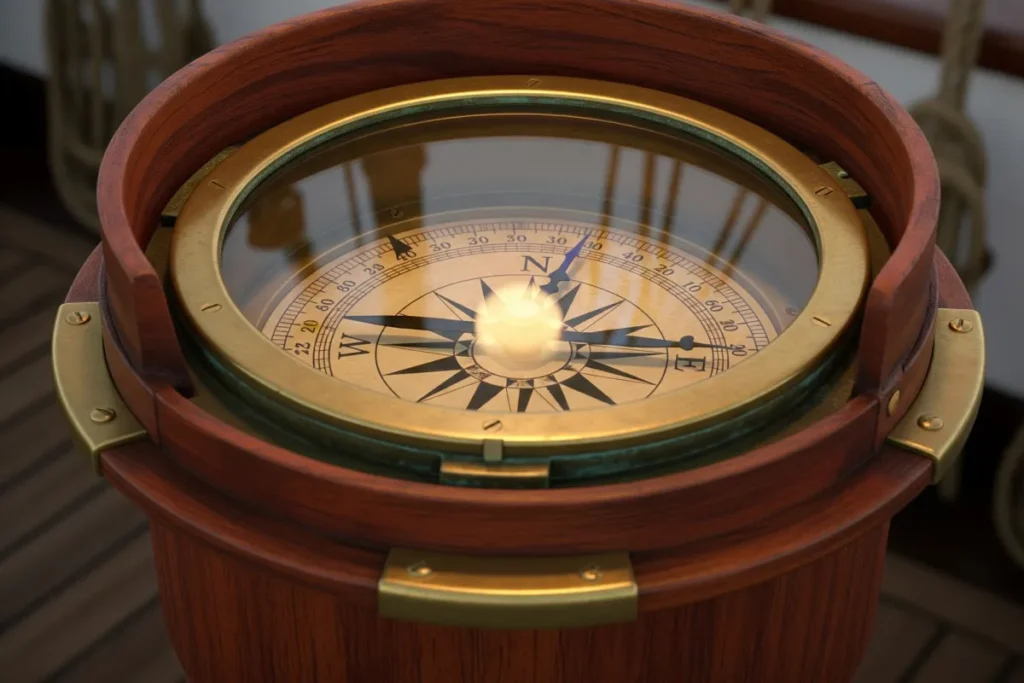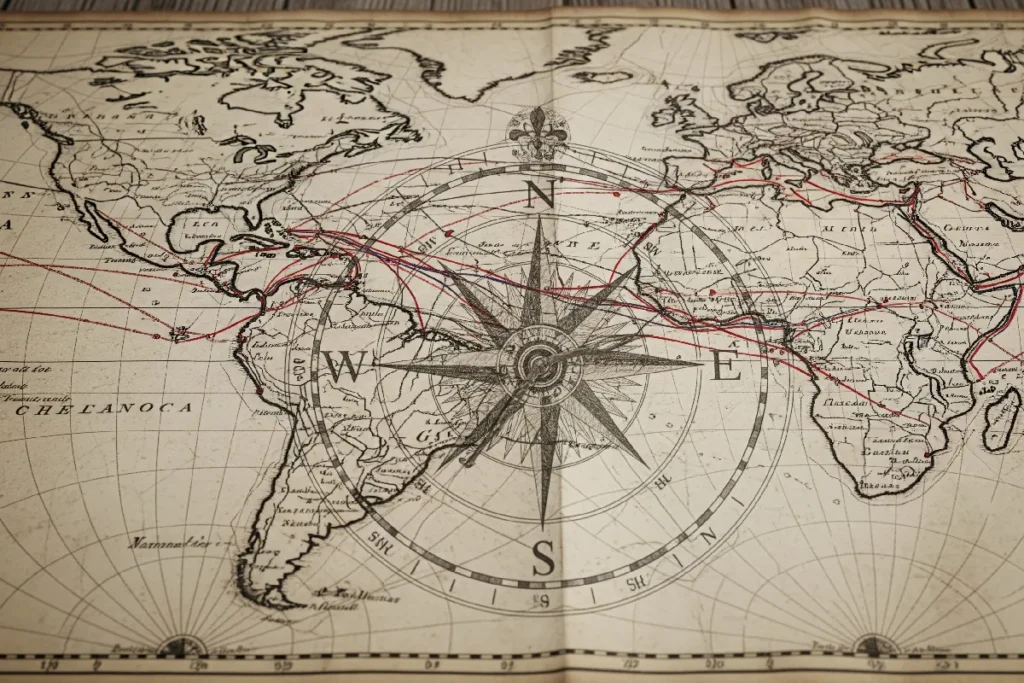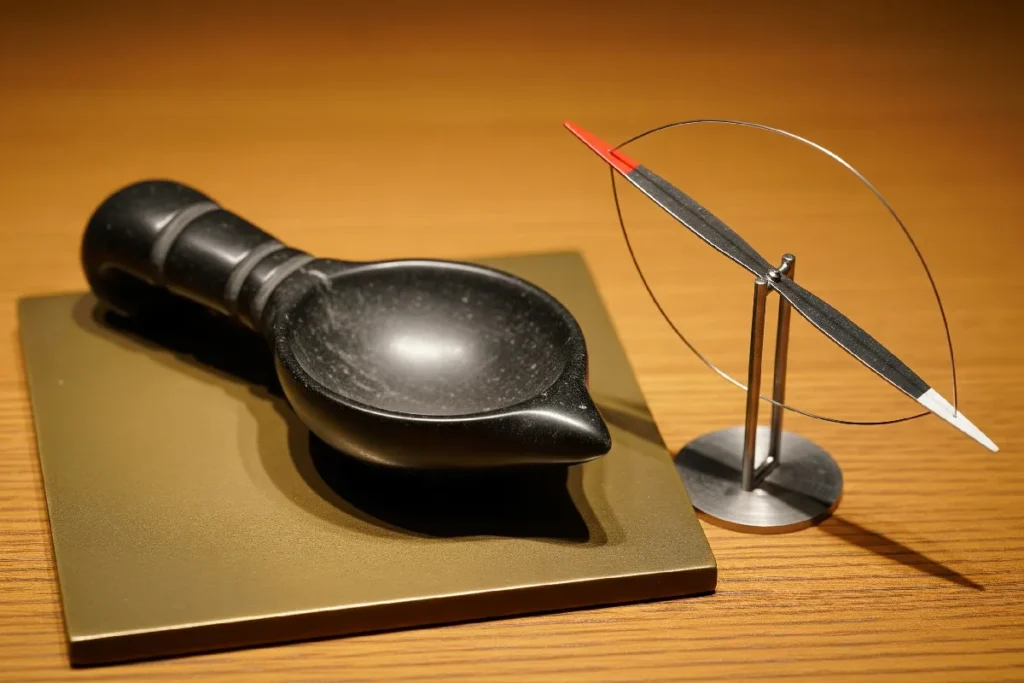Explores the history of the compass from geomancy to global navigation — and how it enabled trade, conquest, and the erasure of local geographies.
Table of Contents
Introduction
The history of the compass is not a simple story of progress. Before it was a tool of navigation, it was an oracle—a lodestone spoon used by Chinese mystics not to cross oceans, but to align lives with the silent, cosmic forces of the earth. We are taught to see it as a neutral, almost magical guide, an unwavering needle that innocently points north. This romanticized image, however, conceals a far more troubling reality. The compass was not merely a guide; it was an accomplice. Its true history is one of quiet betrayal, an instrument that promised direction but delivered dominance, charting a course for both celebrated discovery and systematic erasure.
This sanitized narrative is the core of the problem. By framing the compass as a simple tool for exploration, we ignore its pivotal role as a weapon of empire. It was the technological key that unlocked the world for European expansion, turning perilous voyages into calculated ventures of trade, conquest, and brutal subjugation. The steady needle made colonialism scalable, guiding ships on the transatlantic slave trade and along violently enforced colonial routes with cold, logistical precision. Rethinking the history of the compass means confronting this uncomfortable truth: the same instrument that guided explorers also guided conquerors, fundamentally remapping global power dynamics in favor of the few.
This article peels back the layers of this complex and often flawed history of the compass. We will trace its evolution from a spiritual object in ancient China to the indispensable tool that charted the course for European empires. We will then confront its devastating impact on indigenous navigational traditions, exploring how it imposed a single, Eurocentric worldview that systematically silenced other ways of knowing. Finally, we will examine how the foundational logic of the compass endures today in our digital navigation systems, forcing us to ask whether our modern tools are destined to repeat the same patterns of control and erasure.
From Mystic Oracle to Mariner’s Tool: The Early History of the Compass
To understand the unsettling legacy of the compass, we must first look past its familiar form and delve into an earlier, more esoteric history. The accepted history of the compass begins not on the high seas but on the divining boards of Han dynasty China. Here, around the 2nd century BCE, practitioners of geomancy used spoon-shaped lodestones that would swivel to align with the earth’s magnetic field. This early device was not for navigation but for divination—an instrument to orient homes and lives in harmony with cosmic forces. Its purpose was both spiritual and terrestrial, a tool to understand one’s place within a given landscape, rather than to conquer a new one.
The gradual compass technology evolution from a mystical object to a mariner’s guide marks a profound shift in human ambition. By the 11th century, Chinese engineers had figured out that the same magnetic properties could be used for navigation, magnetizing iron needles and floating them in bowls of water. This simple but revolutionary technology slowly trickled westward along the Silk Road and maritime trade routes, reaching the Arab world and Europe by the 12th and 13th centuries. The initial history of the compass in the West is murky, but its adoption was swift and transformative, signaling a departure from coast-hugging journeys and reliance on celestial bodies alone.
This transition was cemented with the development of the dry-pivoted compass in Europe around 1300. Encasing the needle in a box with a wind rose and mounting it on a pin made the instrument far more stable and practical for the violent pitching of a ship at sea. This refinement wasn’t just an upgrade; it was the final step in turning a spiritual oracle into a cold, pragmatic instrument of expansion. The tool was now ready to be weaponized, its needle no longer pointing toward cosmic balance but toward distant lands ripe for exploitation. This pivotal moment laid the technical groundwork for a new, brutal chapter in the history of the compass.

Charting the Course for Empire: The Compass in the Age of “Discovery”
The refinement of the magnetic compass was the technological catalyst for Europe’s so-called “Age of Discovery.” This benign framing masks a more violent truth: the compass made global conquest possible. Paired with other maritime exploration tools like the astrolabe for latitude and the portolan chart for coastlines, the compass provided the final, crucial piece of the navigational puzzle—a reliable sense of direction on the open, featureless ocean. It emboldened mariners to sail beyond the sight of land, not merely for exploration, but to establish and enforce dominance over vast new territories. The history of the compass from this point forward is inextricably linked to the history of the empire.
This newfound reliability turned perilous voyages into calculated business ventures. The ability to consistently and efficiently traverse oceans was the bedrock upon which colonial empires were built. This flawed history of the compass is one where its needle pointed directly toward profit, extracted at an immense human cost. European powers could now dispatch fleets with a high degree of confidence that they would reach their intended destinations, whether to plunder resources, establish trading posts, or transport enslaved people. The compass became the enabler of a global economic system rooted in violent extraction and subjugation, making colonialism a scalable and brutally efficient enterprise.
The dark legacy of the compass and colonial routes is most evident in the transatlantic slave trade and the monopolistic spice routes. European ships, guided by the steadfast needle, became the engines of the Middle Passage, transporting millions of Africans into bondage with navigational precision. Similarly, the control of the spice trade in Asia depended on the ability to dominate sea lanes, a feat impossible without the compass. The instrument was not a passive observer in these atrocities; it was an active participant, a silent co-conspirator that made the systematic exploitation of entire continents logistically achievable. The consequences of the history of the compass are written in the blood and treasure of these routes.
The Needle and the Damage Done: Erasing Local Geographies
The quietest betrayal in the history of the compass lies not in the routes it charted, but in the knowledge it erased. The European model of navigation was abstract and imperial; it relied on instruments to impose a universal grid of longitude and latitude onto the world. This approach stood in stark contrast to the deeply contextual, place-based wayfinding traditions of indigenous cultures. For instance, Polynesian navigators sailed vast stretches of the Pacific using sophisticated knowledge of wave patterns, star paths, and the flight of birds—a system captured in intricate stick charts that were as much a spiritual map as a physical one. Theirs was a navigation of intimacy with the ocean, not mastery over it.
The arrival of the compass-wielding European marked the beginning of a profound epistemic violence. The instrument imposed a standardized, Eurocentric worldview that recognized only one valid way of knowing and traversing the globe. Indigenous cartographies, rich with local meaning and ancestral stories, were dismissed as primitive or irrelevant. The world was redrawn according to the rigid logic of the magnetic north, overwriting complex local geographies with the clean, empty lines of the colonial chart. This wasn’t merely a technological replacement; it was a deliberate act of cultural erasure, a key chapter in rethinking the history of the compass.
The lasting consequences of this erasure are devastating. Forcing a single, instrument-based navigational model upon the world severed deep-rooted connections between communities and their ancestral lands and seas. The loss of traditional wayfinding techniques meant the loss of languages, stories, and entire systems of ecological knowledge. This component of the history of the compass reveals the instrument not just as a tool for physical conquest, but as a weapon of cultural homogenization. In valuing only the direction its needle pointed, it invalidated the countless other ways humanity had learned to find its way home.

Rethinking the History of the Compass in the Modern Era
The magnetic needle in a box may seem archaic, but its soul lives on within the cold logic of our most advanced navigational technologies. The direct lineage from the history of the compass to the Global Positioning System (GPS) is undeniable. Both systems operate on the same fundamental principle: providing a universal, abstract grid to overlay upon the world, divorcing the act of navigation from any specific environmental or cultural context. Today, our compass is a satellite, our needle a blue dot on a screen. This technological leap has only amplified the detachment, rendering us even more reliant on a disembodied, top-down perspective that tells us where to go without requiring us to understand where we are.
This foundational logic of standardized, instrument-based navigation continues to shape our world in profound ways. The intricate global supply chains that define modern capitalism are merely an optimized version of the old compass and colonial routes, managed with the ruthless efficiency of GPS logistics. Furthermore, the inherent biases of colonial cartography persist in our digital maps. The continued use of projections like the Mercator in popular map apps distorts global geography, inflating the size of Europe and North America while shrinking Africa and South America, subtly reinforcing a colonial worldview. The flawed history of the compass is still being written in silicon.
Yet, a powerful counter-movement is underway. Around the world, communities are actively working to decolonize cartography and reclaim their geographical narratives. This takes the form of projects that reintroduce indigenous place names onto official maps, educational programs that revive traditional wayfinding techniques, and the creation of new maps that prioritize cultural landmarks over colonial infrastructure. These efforts are not exercises in nostalgia; they are vital acts of cultural and political reclamation. By challenging the dominance of a single navigational logic, they are actively rethinking the history of the compass and charting a more equitable way forward.
An Enduring Legacy: Does the Modern Compass Point Toward Progress?
The complete history of the compass reveals its profound dual identity. It was simultaneously a tool of incredible human ingenuity that fostered connection across vast oceans and an instrument of brutal imperial conquest that shattered entire civilizations. To celebrate the former while ignoring the latter is to accept a sanitized and dangerous fiction. The compass did not simply show the way; it created a specific way of seeing the world—a world of straight lines, abstract grids, and territories to be claimed. Its legacy is one of both sublime discovery and unspeakable violence, a paradox we are still grappling with today.
Our transition from the physical compass to invisible, complex satellite systems represents a monumental philosophical shift. We have traded the tangible connection to the Earth’s magnetic field for an absolute reliance on a network we cannot see or truly comprehend. This has given us unprecedented accuracy and convenience, but at what cost? In outsourcing our directional sense to algorithms, we risk losing not only our innate cognitive mapping abilities but also our critical awareness. The unquestioning trust we place in the blue dot is a modern, more subtle version of the blind faith sailors once placed in the needle, and it makes us vulnerable to new forms of manipulation and control.
As we stand on the cusp of yet another navigational revolution, powered by artificial intelligence and augmented reality, we must confront the central question this history poses. Will our new tools repeat the exploitative patterns established by the long, and often unforgiving, history of the compass? Or can we design them to foster genuine understanding, respect local knowledge, and promote a more equitable way of moving through the world? The modern compass points wherever we tell it to; the true test is whether we have learned anything from the directions it has taken us in the past.

Conclusion
We have traced the long and shadowed history of the compass, following its path from a divinatory tool in Han China to the linchpin of European colonial expansion. This journey reveals that its development was never neutral. Instead, the compass became an instrument of power, providing the logistical confidence required to build global empires and enforce exploitative trade routes, such as the transatlantic slave trade. In doing so, it championed a single, abstract mode of navigation that actively erased the rich, place-based wayfinding traditions of indigenous cultures, inflicting a deep and lasting epistemic violence upon the world. The consequences of the history of the compass were not merely geographic, but profoundly cultural.
The central message of this exploration is that the compass was far more than a simple needle pointing north; it was an agent of worldview imposition. Its widespread adoption established a new global hierarchy, one that privileged the detached, instrument-driven navigation of the colonizer over the intimate, environmental knowledge of the colonized. This remapped not only the physical world with new lines on a chart but also the very structures of power and identity. The quiet betrayal of the compass lies in its legacy: presenting a single, dominant way of seeing the world as the only one that mattered, a logic that persists to this day.
Therefore, as we navigate our modern world with the descendants of the compass—the GPS in our pockets and the satellites overhead—we must carry this critical history with us. The tools have changed, but the underlying questions of power remain. We must relentlessly ask who designs our navigational systems, whose geographies they prioritize, and whose they render invisible. To truly find our way forward, we must learn to look beyond the simple blue dot on the screen and challenge the embedded histories within the technologies that guide us, ensuring they do not lead us down the same dark routes of the past.








